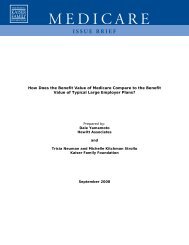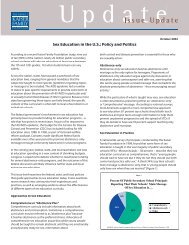HEALTH CARE COSTS: A PRimER - The Henry J. Kaiser Family ...
HEALTH CARE COSTS: A PRimER - The Henry J. Kaiser Family ...
HEALTH CARE COSTS: A PRimER - The Henry J. Kaiser Family ...
Create successful ePaper yourself
Turn your PDF publications into a flip-book with our unique Google optimized e-Paper software.
Payment and delivery system reforms also could have a moderating effect on the<br />
diffusion and use of new technologies in some cases. Payment approaches that<br />
bundle payments or otherwise shift risk to groups of providers for the cost or use of<br />
services may discourage them from investing in or using new services or technologies<br />
where value is not clear or appreciably better than current treatments. Providers that<br />
share a fixed or contingent payment for a bundle of services are likely to be critical of<br />
investments that incur new costs without corresponding benefits. As of now, very little<br />
of overall health spending is made through bundled or at risk payments, so this<br />
influence is likely to be small unless new payment approaches become more common<br />
and more coordinated delivery arrangements evolve.<br />
Provisions in the health reform law (ACA) that affect health care costs. <strong>The</strong> ACA<br />
makes many changes to the way health coverage and health care will be provided and<br />
paid for in the future, both in public and in private settings. <strong>The</strong> law includes a<br />
requirement, with some exceptions, that people obtain health insurance, creates new<br />
sources of coverage through health insurance exchanges, provides for premium and<br />
cost-sharing subsidies for those with low incomes, significantly expands Medicaid<br />
eligibility, makes benefit changes and other changes designed to slow the growth of<br />
Medicare spending, restructures the private health insurance market, and includes<br />
numerous other health-related provisions. While the expansion of insurance coverage<br />
under the ACA will increase the level of health care spending in the short term, the<br />
Centers for Medicare and Medicaid Services has estimated that after an initial<br />
increase, many of the law’s provisions will lower the rate of growth of health care<br />
spending over time. 40 Many of the law’s provisions won’t be implemented until 2014.<br />
<strong>The</strong> health care cost containment provisions in the ACA include those designed to<br />
control costs in both the short-term and long-term. 41 Some of the short-term<br />
approaches, which aim to reduce the level of health care costs rather than their growth<br />
rate, include: reducing payments to providers (e.g., reducing payments to Medicare<br />
Advantage plans, reducing the update factor for Medicare hospital payments,<br />
increasing the rebates that pharmaceutical companies pay to Medicaid plans);<br />
eliminating unnecessary costs such as fraud and abuse in Medicare and Medicaid;<br />
simplifying health insurance administration by creating uniform electronic standards<br />
and operating rules for all private insurers, Medicare, and Medicaid; implementing<br />
hospital value-based purchasing programs; and establishing an approval process for<br />
generic biologic agents.<br />
Other ACA provisions are designed to make health system changes that would address<br />
rising costs over the long term, primarily by making the delivery of medical services<br />
more efficient and less costly. A new Center for Medicare and Medicaid Innovation will<br />
create and evaluate experimental models in health care delivery, care coordination,<br />
and payment including: the Medicare Shared Savings Program where groups of health<br />
care providers known as accountable care organizations will coordinate their services<br />
to patients and will be allowed to share in any cost savings; programs to test methods<br />
to “bundle” services from different providers so that Medicare and Medicaid<br />
beneficiaries receive more coordinated and more efficient care; patient-centered<br />
medical homes for patients with chronic illness; contracts to states to develop models<br />
to improve the quality and coordination of care for patients eligible for both Medicare<br />
and Medicaid (“dual eligibles”). It is hoped that these Medicare and Medicaid models,<br />
if successful, could be applied to the total population. Other long-term approaches in<br />
the ACA include a new Independent Payment Advisory Board which, in addition to its<br />
<strong>HEALTH</strong> <strong>CARE</strong> <strong>COSTS</strong>: KEY INFORMATION ON <strong>HEALTH</strong> <strong>CARE</strong> <strong>COSTS</strong> AND THEIR IMPACT<br />
29












